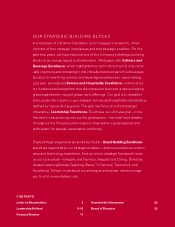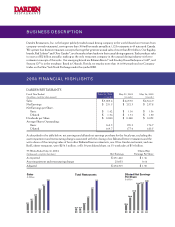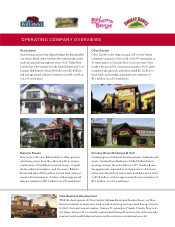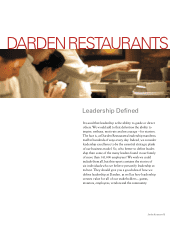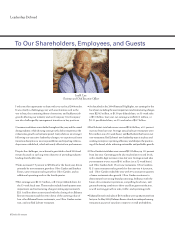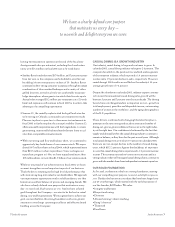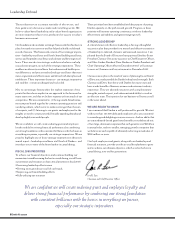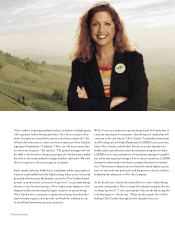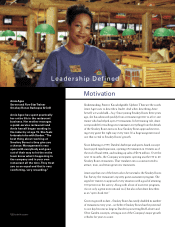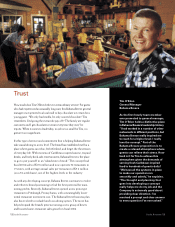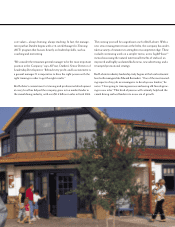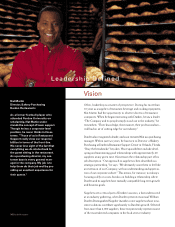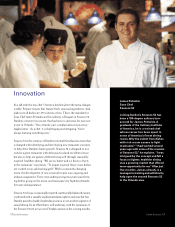Red Lobster 2004 Annual Report Download - page 7
Download and view the complete annual report
Please find page 7 of the 2004 Red Lobster annual report below. You can navigate through the pages in the report by either clicking on the pages listed below, or by using the keyword search tool below to find specific information within the annual report.
7 7
leaving 32 restaurants in operation at the end of the fiscal year.
Average annual sales per restaurant, excluding the closed restau-
rants, were $5.2 million in fiscal 2004 (on a 52-week basis).
• Smokey Bones’ total sales were $174 million, an 87 percent increase
from last year, as the company nearly doubled in size this year
by adding 30 new restaurants to its base of 39. Smokey Bones
continued to drive strong consumer acceptance through its unique
combination of slow-smoked barbeque and a variety of other
grilled favorites, served in a lively yet comfortable mountain-
lodge atmosphere, where guests can watch their favorite sports.
Annual sales averaged $3.2 million per restaurant (on a 52-week
basis) and expansion will continue in fiscal 2005 as it seeks to take
advantage of a compelling opportunity.
• Seasons 52, the casually sophisticated fresh grill and wine bar
we’re testing in Orlando, continued to post impressive results.
Plans are in place to open two to three more test restaurants in
fiscal 2005 to further explore the concept’s viability. Seasons 52
offers seasonally inspired menus with fresh ingredients, to create
great tasting, nutritionally balanced meals that are lower in cal-
ories than comparable restaurant meals.
• With our strong cash flow and balance sheet, we continued to
aggressively buy back shares of our common stock. We repur-
chased 10.7 million shares in fiscal 2004, which represented more
than $235 million in share repurchases. Since we began our
repurchase program in 1996, we have repurchased more than
109 million shares, or more than $1.5 billion of our common stock.
While we are proud of our achievements in fiscal 2004, we know
we must strengthen several important aspects of our business.
That’s the key to returning to the high level of performance that
will create strong long-term value for our shareholders. We approach
our improvement opportunities with a solid foundation, one that
features an excellent balance of proven and emerging brands. We
also have a clearly defined core purpose that motivates us every
day – . And we have a shared
goal throughout the Company – we want to be the best in casual
dining, now and for generations. We recognize that to achieve our
goal, we must build on this strong foundation with even greater
attention to two things: operating excellence and effective brand
building across the Company.
CASUALDININGISAGROWTHINDUSTRY
Our industry, casual dining, is large and continues to grow. In
calendar 2003, casual dining industry sales grew 2.6 percent. This
compares favorably to the quick-service and mid-scale segments
of the restaurant industry, which reported a 1.4 percent increase
in sales and a 1.9 percent decline in sales, respectively. However,
casual dining’s 2003 results are well below the industry’s 10-year
average growth rate of 7.4 percent.
Despite the slowdown in calendar 2003, industry experts continue
to forecast that annualized casual dining sales growth will be
between 5 percent and 7 percent over the next decade. The driving
factors have not changed and are as important as ever – growth in
total employment, growth in real disposable income, an increasing
number of women in the workforce, and the aging demographics
of the U.S. population.
These drivers, combined with changing lifestyles that place a
premium on the time-saving and social reconnection benefits of
dining out, give us great confidence that we are in the right indus-
try at the right time. Our confidence is buttressed by the fact that
supply and demand within the casual dining industry continue to
remain in balance, as they have for the past several years. Although
total casual dining visits were down 0.3 percent in calendar 2003,
there was an even steeper decline in the number of casual dining
units, which fell 2.2 percent. Against that backdrop, it’s important
to note that casual dining chains experienced a 1.0 percent increase
in units. This continues a trend we’ve seen in recent years and is a
strong indicator that well-managed casual dining chains continue to
grow and take market share from independent restaurant operators.
OURSOLIDFOUNDATION
As I’ve said, our business is built on a strong foundation, starting
with our compelling core purpose,
. Darden also has seven core values that have been forged over
our 65-year heritage, which started with the early businesses of
our late founder, Bill Darden. We value:
• Integrity and fairness
• Respect and caring
• Diversity
• Always learning / always teaching
• Being “of service”
• Teamwork
• Excellence


